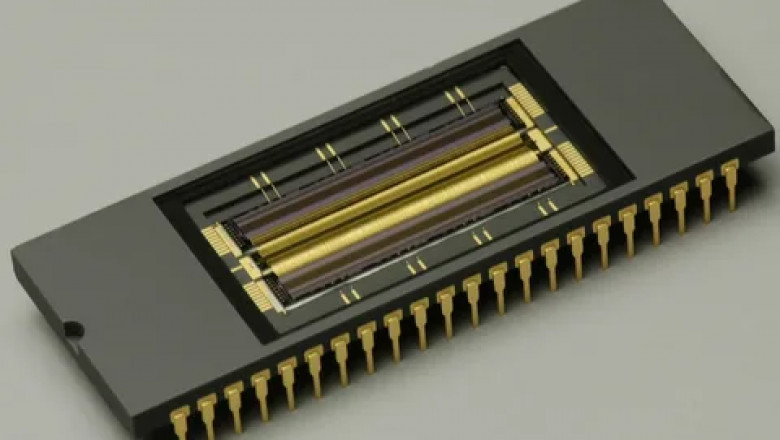views
Latest InGaAs Image Sensors Market Overview Reveals Expanding Applications Across Aerospace and Biomedical Sectors
Introduction
The InGaAs image sensors market is witnessing substantial growth, driven by increasing demand for shortwave infrared (SWIR) imaging in aerospace and biomedical applications. Indium Gallium Arsenide (InGaAs) sensors offer high sensitivity in the near-infrared (NIR) and SWIR wavelength ranges (900 nm to 1700 nm), making them essential for space exploration, defense surveillance, remote sensing, and medical imaging.
With continuous technological advancements, miniaturization, and cost reduction, the InGaAs image sensors market is expanding into new domains, including hyperspectral imaging, satellite-based monitoring, non-invasive diagnostics, and biomedical research. This article provides an overview of the latest market trends, key growth drivers, and emerging opportunities in these two high-growth sectors.
Expanding Applications of InGaAs Image Sensors in Aerospace
1. Satellite Imaging and Remote Sensing
The aerospace industry is increasingly relying on InGaAs image sensors for high-resolution satellite imaging and remote sensing. These sensors are ideal for detecting thermal signatures, geological compositions, and atmospheric conditions, offering superior performance in climate monitoring, environmental assessment, and agricultural analysis.
Satellite-based hyperspectral imaging powered by InGaAs sensors helps identify mineral compositions, water bodies, vegetation health, and urban development trends. As governments and private space agencies continue investing in earth observation satellites, the InGaAs image sensors market is poised for further expansion.
2. Space Exploration and Deep-Space Imaging
Space agencies such as NASA, ESA, and private space firms are integrating InGaAs sensors into their deep-space telescopes and planetary exploration missions. SWIR imaging allows astronomers to study celestial bodies, detect distant galaxies, and analyze infrared radiation emitted by stars and exoplanets.
With upcoming space missions focusing on Mars, the Moon, and asteroid mining, demand for radiation-resistant and high-sensitivity InGaAs sensors is expected to rise significantly.
3. Defense and Military Surveillance
InGaAs image sensors play a critical role in aerospace defense applications, including night vision systems, target tracking, and UAV-based reconnaissance. These sensors enhance low-light visibility and can detect concealed threats such as camouflaged objects and hidden enemy positions.
Military forces worldwide are increasingly adopting SWIR imaging technologies for border surveillance, missile tracking, and infrared-guided weapon systems, driving the InGaAs image sensors market in the defense sector.
4. Aircraft Navigation and Safety Systems
Modern aircraft are integrating SWIR-based InGaAs sensors into their navigation, landing assistance, and collision avoidance systems. These sensors improve visibility during foggy or low-light conditions, enhancing pilot safety and flight efficiency.
As the aerospace industry focuses on autonomous flight systems and AI-powered aircraft navigation, the adoption of InGaAs image sensors is expected to increase.
Rising Adoption of InGaAs Image Sensors in Biomedical Applications
1. Non-Invasive Medical Imaging and Diagnostics
The biomedical industry is leveraging InGaAs image sensors for non-invasive medical imaging, particularly in blood oxygenation monitoring, fluorescence imaging, and early disease detection. SWIR imaging allows for deeper tissue penetration, enabling precise visualization of veins, tumors, and internal organs without harmful radiation.
With growing demand for advanced diagnostic techniques, hospitals and research institutions are investing in InGaAs-based imaging solutions for real-time monitoring and improved patient outcomes.
2. Hyperspectral Imaging in Disease Detection
Hyperspectral imaging powered by InGaAs sensors is revolutionizing medical research and diagnostics. These sensors help detect biomolecular changes in tissues, assisting in the early diagnosis of cancer, skin diseases, and neurological disorders.
Biomedical researchers are exploring the potential of SWIR imaging for detecting Alzheimer’s disease biomarkers, guiding laser-assisted surgeries, and improving pharmaceutical drug development.
3. Surgical Assistance and Endoscopy
Modern surgical procedures are increasingly incorporating SWIR-based imaging systems for enhanced visualization of blood flow, tissue structures, and internal abnormalities. InGaAs sensors are used in minimally invasive endoscopic procedures, providing clearer imaging with reduced patient discomfort.
With advancements in robot-assisted surgeries and AI-powered medical imaging, the demand for high-resolution InGaAs sensors is expected to surge.
4. Biophotonics and Optical Coherence Tomography (OCT)
The field of biophotonics is utilizing InGaAs image sensors for optical coherence tomography (OCT), a technique widely used in ophthalmology, dermatology, and cardiovascular imaging. SWIR-based OCT systems offer high-contrast imaging of retinal layers and coronary arteries, improving early diagnosis and treatment planning.
As healthcare technology evolves, InGaAs sensors will continue to drive innovations in medical imaging and biophotonics.
Key Market Trends and Future Outlook
1. Miniaturization and Cost Reduction
One of the biggest challenges in the InGaAs image sensors market has been the high cost of these sensors. However, advancements in wafer-level manufacturing and sensor miniaturization are making InGaAs technology more affordable and accessible for emerging applications.
2. AI Integration for Advanced Imaging
The integration of AI and machine learning in SWIR imaging is transforming the aerospace and biomedical sectors. AI-powered InGaAs imaging solutions enhance object recognition, automated diagnostics, and predictive maintenance in defense, healthcare, and industrial automation.
3. Growing Investment in R&D and Commercial Applications
With increased funding from government space agencies, healthcare organizations, and defense departments, the InGaAs image sensors market is set to witness rapid commercialization. Investments in quantum dot-based InGaAs sensors and flexible SWIR imaging solutions are expected to shape future innovations.
4. Expanding Role in Smart Cities and IoT-Based Monitoring
As smart city initiatives gain momentum, InGaAs image sensors are being integrated into IoT-based environmental monitoring, infrastructure inspection, and air quality assessment. SWIR sensors provide valuable data for sustainable urban development and disaster management.
Conclusion
The latest InGaAs image sensors market overview highlights expanding applications across the aerospace and biomedical sectors, driven by advancements in SWIR imaging, AI integration, and hyperspectral imaging. From space exploration and defense surveillance to medical diagnostics and biophotonics, InGaAs sensors are transforming industries with their high sensitivity, precision, and non-invasive imaging capabilities.
With continuous R&D efforts, cost reduction, and commercialization of SWIR technologies, the InGaAs image sensors market is expected to grow rapidly in the coming years. Companies investing in next-generation imaging solutions, AI-driven analytics, and emerging biomedical applications will be well-positioned to capitalize on this expanding market.






















Comments
0 comment